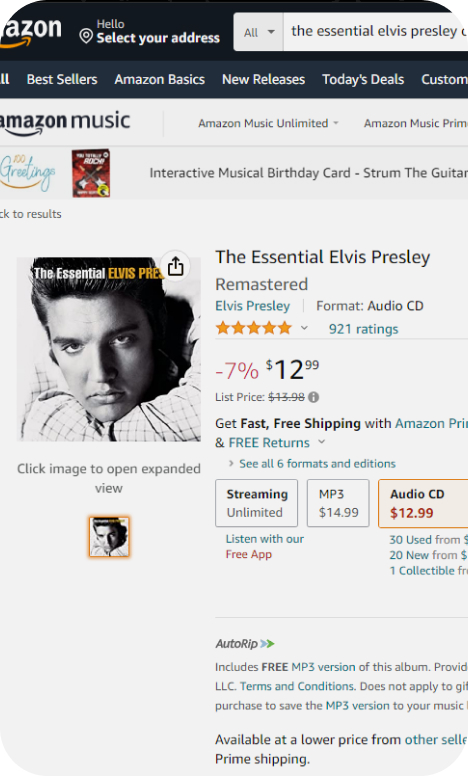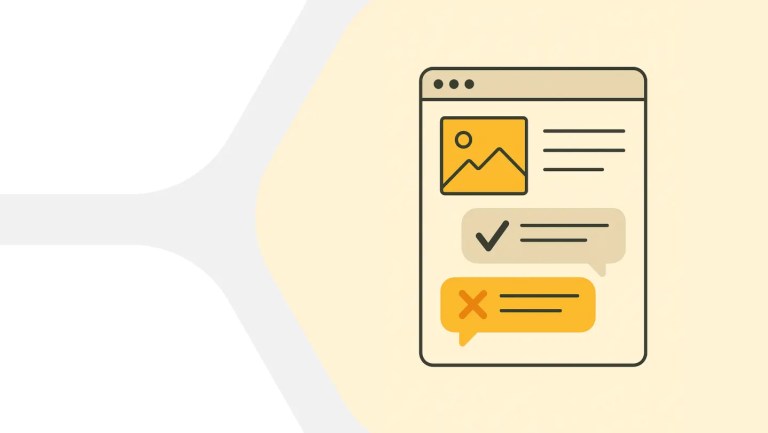With a smashing 94% of first impressions of a website linked to its design (Source: Web FX), user-centered design should be considered the go-to approach for creating products that truly resonate with their intended users.
User-centered design is an approach to design by which the needs as well as preferences of the users are placed at the heart of the design process.
Crafting digital products or services using a user-centered design can guarantee a pleasurable and frictionless user experience. At the core of the user-centered approach lies the involvement of the user every step of the way in the design and development process.
Keep reading to learn how you can incorporate the user-centered design philosophy into your own products 😎
What Is User-Centered Design (UCD)?
User-centered design is an approach to design where user needs as well as any user limitations are at the center of the design and the development process.
By doing so, user-centered design has as the main goal to help designers and product managers craft products that are not only working well but also are in line with the expectations of the users.
This approach offers slick and memorable product experiences that users want more of. 💥
Benefits of Implementing User-Centered Design
User-centered design has a host of benefits for the user and the business alike. Here are the key ones:
1. Increased User Satisfaction and Brand Loyalty
By adopting a user-centered design approach throughout your design and development cycle, you have a unique opportunity to create functional products that are in line with the user’s expectations.
The combination of good functionality and intuitive design can skyrocket the satisfaction rates of your users and consequently lead to stronger brand loyalty.
2. Reduced Design Learning Curve
When a digital product is designed with the user at the forefront, the end result is an intuitive and frictionless system-user interaction.
By crafting products in line with the main user-centered design principles, designers have the opportunity to create interfaces that are in line with the user’s mental model. This approach ensures that the learning curve to ‘learn’ how to use the software is reduced.
This leads to better onboarding and great adoption rates.
3. Increased Adoption Rates
The user-centered design approach is all about aligning user needs with product features. It goes without saying that users will always choose products that meet their needs over other products in the market with more features or better branding.
In this way, adopting a user-centered philosophy can result in products with higher adoption rates and users that are hooked!

4. Reduced Development and Customer Support Costs
A user-centered approach when building products . This ensures that users are highly involved from the early stages of the design and development process.
This means that the user feedback is incorporated throughout the product lifecycle. Moreover, the product is well-designed and functioning at all times, saving thousands in costly redesigns and overworked customer support teams.
5. Higher Conversions
Adopting a user-centered approach ensures that your product not only works like a well-oiled machine at all times. Additionally, it is highly optimized when it comes to usability and overall user experience.
This overall positive user experience can lead to higher conversion rates. Users will be more likely to complete tasks on an interface, resulting in increased revenue.
Focus Areas of User-Centered Design (UCD)
Here are the main focus areas of user-centered design:
Usability
Usability is central in user-centered design. User-centered design is all about creating products that the users find easy to use, with intuitive navigation and streamlined interfaces that help them achieve their goals. 🎯
User-centered design can reduce friction and remove sticking points enhancing in this way the overall user experience.
User Empathy
Another major focus of user-centered design is the empathy for the user. User empathy revolves around understanding not only the needs and expectations of your intended audience but also their pain points and limitations.
A user-centered approach to design requires the designer to step into the user’s reality and deep-dive into their behaviors to consequently be able to empathize with them and craft products that are aligned with the user’s needs. One of the best ways to promote empathy is to create an empathy map. ⬇️
Accessibility
Accessibility is at the core of the user-centered design approach. USD is all about offering accessible digital products and services that take into account the different abilities and limitations of the users, offering a more inclusive user experience overall.
For example, color contrast would be something that USD will be looking at to make sure that the webpage is readable.

Information Architecture
The user-centered design approach highlights the importance of clear information architecture.
USD is all about optimizing and streamlining user journey. With this approach the organization of the information is given extra love.
Reducing the user’s cognitive load should be at the top of mind when designing products with the USD philosophy.
Visual Design
Visual design is also focal in the user-centered philosophy. An aesthetically pleasing design can not only help to grab the user’s attention but also create emotions of trust, safety, and ease which can help with the adoption of the products.
Interaction Design
Last but not least, user-centered design is also concerned with the element of the human and computer interaction.
It revolves around designing elements such as forms or buttons that permit the interaction of the user with the system. This effort to help the user complete their desired goals effectively and efficiently.
User-Centered Design Process
Here is a step-by-step guide to nailing your user-centered design process:
Conduct Extensive User Research
User-centered design is deeply rooted in understanding the needs and limitations of your intended users. Therefore, rigorous and extensive user research is the first step of the user-centered design process.
By conducting research studies or gathering qualitative data through software, designers and product managers have a unique opportunity to gather insights about their target users and their behaviors.
There is an abundance of different methodologies that you could deploy to get started which will we analyze later in this article.
Or if you are in rush, try our tools in these demos ⬇️
Create a UX Persona
Once you have completed your user research and you are happy with the insights you have collated, your next step is to create your UX personas. These are profiles of users that represent different target groups.
UX personas will help you better understand the needs as well as the pain points of your users. This way, craft design solutions that are aligned with the true needs of your users.
Analyze Design Requirements
Next up is analyzing your design requirements, based on the insights gained from the user research.
Having clear, measurable, and actionable design goals will help you ensure that the needs of the users are in alignment with the needs of the business. This alignment ensures that the solution you are crafting is beneficial for both!
Prototype Your User-Centered Design & Test It
Once your mock-up design is ready, it is time to create a prototype and start testing it! The fidelity of your prototype can vary depending on the stage of the design or development process you are in. However, the main idea is to gather relevant and timely user feedback which you will be able to incorporate into the final design.
❗️Do not forget to test your prototype with users that fall under your UX personas to ensure that the insights gained are relevant.
Launch Your UCD
Once your design has been fine-tuned you are ready to launch it! 🙌🏼
Don’t forget to conduct extensive QA sessions to ensure that all technical and quality standards are met and that the final product is functional!
Continuously Improve Your User-Centered Design
Last but not least, always remember that user-centered design is based on continuous improvement. Once the product is launched regularly test it to ensure that the design always meets the ever-changing user needs and expectations.
User Research Methods for User-Centered Designs
Here are some key research methodologies to consider:
Live Interviews
In-depth live interviews are a great method to gain in-depth insights about your users. This methodology involves meeting with users online or face-to-face and asking them targeted questions.
These interviews can give you juicy qualitative insights and allow you to step into your user’s shoes and empathize with them.
Moderated Testing
Moderating testing is a methodology that revolves around observing your users while they try to complete a specific task you have set for them on an interface, with the help of a moderator or facilitator.
This method allows for qualitative and quantitative insights to be collected that can shed light on sticking points.
💪🏼The main advantage of this method is that the moderator can ask for clarifications and dive deeper into those insights.
Unmoderated Usability Testing
Unmoderated usability testing is a variation of the usability testing methodology that involves users interacting with an interface without the presence of a facilitator. Instead, automated tools are used to track their interactions.
This is a great method that allows for the collection of large amount of data in a cost-effective way.
Card Sorting
Card sorting is yet another user research method that focuses on the information architecture side of the interface. During a card sorting study, participants are asked to categorize content under, either pre-existing categories or new categories, that they feel like this information would fall under.
User Journey Mapping
Finally, user journey mapping is a methodology that allows designers and researchers alike to visualize the user journey. This is achieved through the visual representation of the different stages that users are going through to complete a goal or a task.
➡️ This method is particularly helpful when you are trying to spot opportunities but also hurdles in the customer journey.
User-Centered Design Examples
Here are some businesses that have nailed their user-centered design:
#1 Apple
Apple is a paradigm of user design. It is no coincidence that Apple’s products are slick and intuitive with unparalleled minimalist design.
By conducting rigorous user research to drill down into the nuances of user behavior and understand user preferences. Apple’s products are designed and developed with the user at the heart.

Source: Apple
#2 Google Search
The iconic search bar by Google is another prime example of stellar user-centered design. Google’s homepage is the epitome of simplicity. It demonstrates at all times that the ease of the users is at the forefront of any other design decisions.

#3 Spotify
Spotify’s easy navigation and highly personalized interface exemplify a product that has been crafted with the user-centered design philosophy in mind. Spotify gets a bonus for the seamless cross-device functionality.
Wrapping Up
Frank Chimero a well-known designer once said that “People ignore design that ignores people.”
By embracing a user-centered approach to design you will be able to craft digital products and services that can constantly delight their intended users. This is because those are aligned with user’s needs.
❗️Do not forget that USD is an iterative process. Continuous user research is at the forefront of this approach to ensure that the products remain always relevant to the ever-evolving needs of the users.
By trying a free option with UXtweak you can make UX pleasurable, not painful🐝








